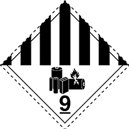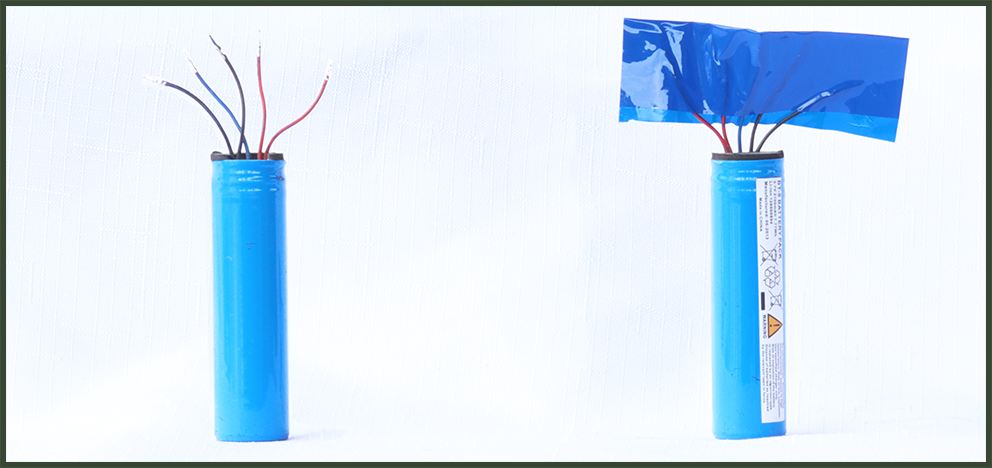Li-Ion Batteries – secondary (rechargeable)
Li-ion batteries come in many shapes and sizes as can be seen from the photo above which shows just a few of the possibilities. If you look closely you will see that the terminals of these batteries have been safely taped with blue tape to prevent short circuit and reduce the risk of fire.
Identifying a li-ion battery
- Many Li-ion batteries look similar to lead acid batteries, and they are not always labelled with a chemistry symbol.
- There are many different types of Li-ion battery and there are many other Li-ion chemistries under development as well.
Application
- Technology is evolving with a variety of chemistry types emerging.
Storage of used li-ion batteries in the home
- Cover terminals with tape to prevent short circuit and minimise risk of fire
- Discharge the energy from the battery if possible and safe
- Store out of reach and stored out of each of children
Components vary depending on the type chemistry
Lithium cobalt oxide (LiCoO2), also known as Li-cobalt.
- Components: Lithium, iron, aluminium, copper, cobalt (up to 24% of battery weight).
Lithium nickel manganese cobalt oxide (LiNiMnCoO2), also known NMC
- Components: Lithium, nickel, manganese, cobalt (up to 8% of battery weight).
Lithium iron phosphate (LiFePO4), (Li-phosphate or Li-ferrous)
- Components: Lithium, iron, phosphate, aluminium, copper, organic electrolyte, graphite
- Manufacturers: Exide Technologies, Heter Electronics Group, Alevo
Lithium manganese oxide (Li-Mn2O4), (Li-manganese, LMO or spinel)
- Components: Lithium, manganese, graphite
- Manufacturers: Century Yuasa
Lithium manganese dioxide (primary battery)
- Components: Lithium, manganese
- Manufacturers: Saft, Sony, Reanata, Duracell, Energizer, etc
Lithium titanate (Li4Ti5O12), (Li-titanate)
- Components: Lithium, manganese with Lithium titanate anode
- Manufacturers: Toshiba, Altairnano, Leclanche, Seiko, YABO
Lithium nickel cobalt aluminium oxide (LiNiCoAlO2), (NCA)
- Components: Lithium, nickel, manganese, cobalt, graphite
- Manufacturers: Large number of unknown brands
Lithium sulphur (Li-S)
- Components:Lithium, sulphur, carbon
Li-iom polymer (Li-ion polymer)
- Components: Can be built on most other lithium chemistries (Li-cobalt, NMC, Li-phosphate and Li-manganese. The anode and cathode materials are the same, but with differences in the electrolyte (solid or gell).
Recyclability varies depending on the type of lithium chemistry.
Lithium cobalt oxide (LiCoO2), also known as Li-cobalt.
- Lithium, iron, aluminium, copper, cobalt.
- Cobalt is up to 24% of battery weight.
Lithium nickel manganese cobalt oxide (LiNiMnCoO2), also known NMC
- Cobalt, nickel, copper, aluminium and carbon can be recovered.
- Have lower value to recyclers than LiCoO2due to reduced cobalt.
Lithium iron phosphate (LiFePO4), (Li-phosphate or Li-ferrous)
- Iron, copper and aluminium can be recovered.
- No cobalt means they have a lower commercial value to recyclers.
Lithium manganese oxide (Li-Mn2O4), (Li-manganese, LMO or spinel)
- Manganese, copper and aluminium can be recovered.
- No cobalt equals lower commercial value to recyclers.
Lithium manganese dioxide (primary battery)
- Manganese, copper and aluminium can be recovered.
- No cobalt equals lower commercial value to recyclers.
Lithium titanate (Li4Ti5O12), (Li-titanate)
- Manganese, copper and aluminium can be recovered; possibly the titanium.
Lithium nickel cobalt aluminium oxide (LiNiCoAlO2), (NCA)
- Cobalt, nickel and manganese can be recovered.
Lithium sulphur (Li-S)
- Unknown
Lithium polymer (Lithium ion polymer)
- Depends on base material
Legal requirements for collectors
- Li-ion batteries are classified as a dangerous good (Class 9).
- Batteries must be packaged and transported in accordance with the Australian Dangerous Goods Code (ADG).
- The export of Li-ion batteries requires a permit from the Australian Government.
Transport packaging labels required by the Australian Dangerous Goods Code


UN Number
- 3480 (used batteries)
- 3481 (contained in equipment)
Health and safety
- Follow manufacturers’ guidelines for safe handling and storage
Packaging for transport
- The Australian Dangerous Goods Code (version 7.4) includes special provisions and packaging instructions for used and damaged Li-ion batteries.




